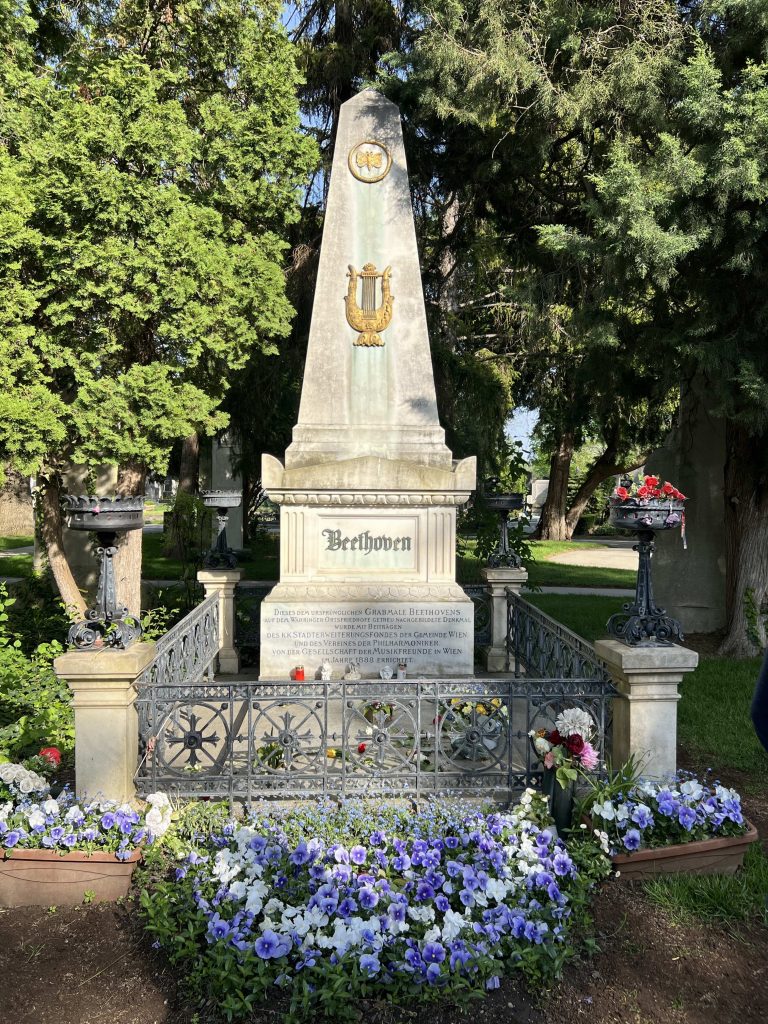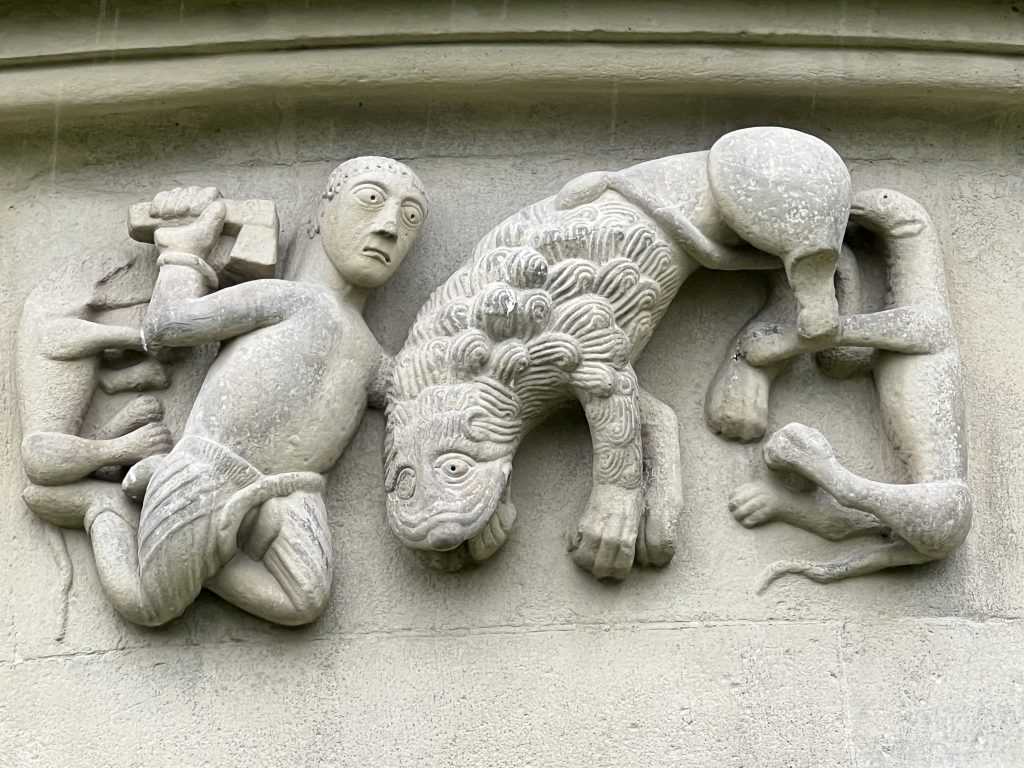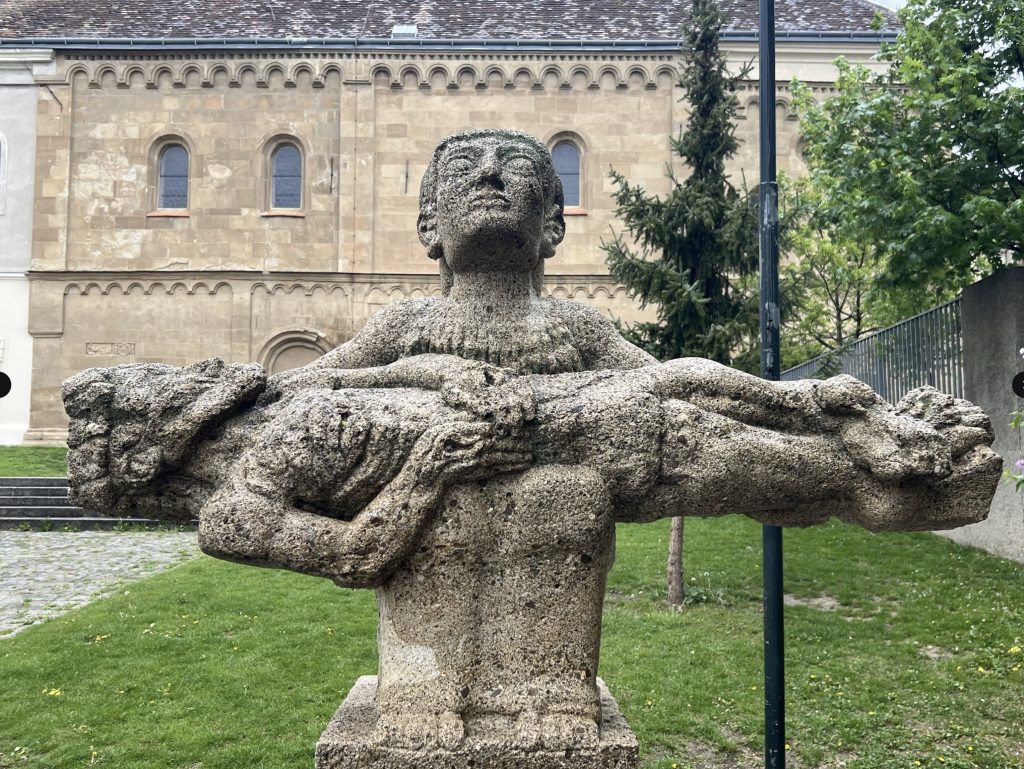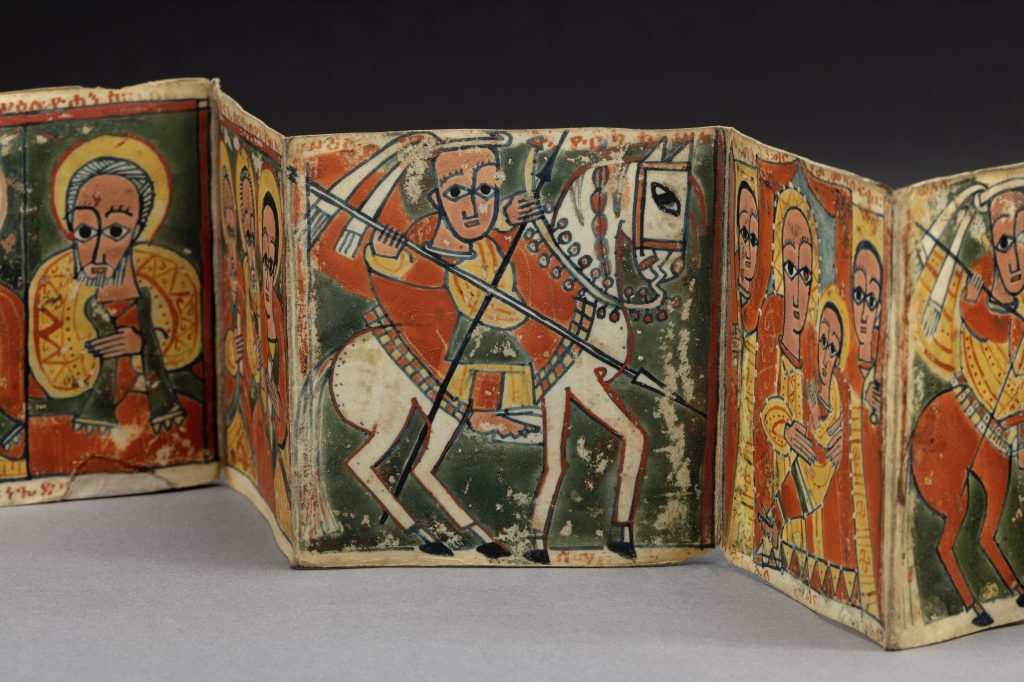ITMOTO, Vienna and Prague
By
by Sue Schardt, In the Margin of the Other (Wed, 4-5:30pET)
Whenever I travel, I try to gather sounds to weave into making a new show, sucking from one margin to pour into the air of anyone who might be listening to WMBR. I’m just back from my first whirlwind visit to Austria and the Czech Republic, and I’m sharing something of what I discovered. You’ll find links to listen and explore the playlist at the end of this post.
It began on a bicycle for most of the first two days I was in Vienna, a city made for bikes. I first went looking for the homes of composers – Beethoven, Mozart, and a stop to gaze up at Sigmund Freud’s office just a few blocks up from Beethoven. It took a lot of figuring the bike rental, so I ran out of time for Schubert. The next day, with the bike rental mastered, I headed to Wiener Zentralfriedhof, the Vienna Central Cemetery. It’s a 45-minute ride to the outskirts of town, and there is a little corner where all of them are buried in a circle: Beethoven, Brahms, Schubert, Hugo Wolf, Strauss (of the waltzes). Mozart is not there because they couldn’t find his body. He was buried just up the road at St. Marx in an unmarked grave. This was routine for the “common people” (aka not of the aristocracy). It also meant that they put somebody else on top of you every ten years. They couldn’t find what might have been left of him when they went looking, but did put a tall marker on the approximate resting space at St. Marx and a second monument in the middle of the other musical dignitaries at the Central Cemetery.

Then it was off to the sounds of the countryside, about forty minutes by train north of Vienna. I walked into the Church of the Nativity of Mary, a Late-Romanesque church (1210-1230) in Schongrabern to hear the organ tuner was at work. You can hear him at the start of the show. I walked about, listening and looking (and lighting a candle to Mary). There is an amazing gothic fresco of St. Christopher spanning the full height of one wall; across is another fresco depicting the devil trying to tempt another creature (a cat?). Outside in the back of the building, sculptures dating from the 14th and 16th centuries. The tuner would sound some tones from up in the choir loft, then turn and pull pipes off the instrument individually for adjustment, then he’d put them back up.


The other country sound in today’s show is a night bird sounding in Wullersdorf, another village just up the road. I bring the song of this beautiful night bird blended into the sound of Saint George’s church bells tolling at noon time. Another ancient church. I’m staying just across the street, a stone’s throw away from the bell, with the bird on my windowsill in the dark before sunrise and managed to catch just one phrase before he flew off and his song became indistinct.
On the long and meandering drive to Prague, I had a dip in a lake surrounded by a bird sanctuary. More bird sounds for another time. Songs of annoyance at my presence rising from tufts of nesting grass.
I set my sights on two used record stores in Prague, this time walking. It was Saturday, and I soon learned that stores close early that day. Phono.cz wasn’t open. On my way over to Japan Vinyl in the main square, I passed by the theater where Mozart debuted “The Marriage of Figaro” and “Don Giovanni.” They’d locked up by the time I arrived. I took photos of the albums displayed in their window, and have done my research to grab and mix some into today’s mix: Don Tosti and his Trio from “Historic Mexican American Music,” a quite wonderful Frenchman (who sings in English), Eric Chenaux, from 1969, Pete Jolly back to back with the early sounds of Isaac Hayes…1967… beautiful cover.
Without record stores, I had to get creative so I rifled through the quite extensive (and interesting) CD collection collecting dust at the AIRbnb we were staying in. It seemed as though most dated to 2005-2008. My sense is that this was someone’s grandmother’s apartment, and they moved in when she died.
There are ghosts of Nazis throughout Vienna and, in Prague, of the subsequent Communist takeover. A word about the sidewalks on the residential streets in the neighborhood I was staying. The sound of my footfalls, moving up and down across the fat-squared cobblestone sidewalks. Biking not so good in Prague. I began to notice small squares of brass or bronze embedded in the walkways alongside the old apartment buildings lining the streets. Cobblestones pulled out and these small square commemorations of where Jewish people had been taken away to the camps. Each included their name, the date they were taken, the name of the camp. I’ve since learned that this practice began in 1996 Berlin – “Stolpersteine”, or “stumbling stones” are the brainchild of Gunter Demnig. There are now some 70,000 blocks in 1,200 cities, making this the largest decentralized monument in the world.
I began to wonder further about my fantasy grandmother who may have lived where I was staying, how she moved through those times. In the midst of the neighbors, the unthinkable happening in the course of a day, buying bread, doing laundry, making dinner, and the family next door pulled onto the street and taken away.
Here I was, in the present, with music stacked on one of her old shelves. I took photos of about thirty of the CDs and drew them in this “travelogue” mix. The Montreal-based Silver Mount Zion Memorial Orchestra starts us out, and from this culling, there’s Lonely Drifter Karen making her debut in the margin, Irishman Alasdair Roberts, Andre 3000 – though I jumped to the present with a ten-minute live performance he gave earlier this year with Stephen Colbert.
So, whoever you are, Grandchild…wherever you are. I’ll guess you’re nearly forty years old by now, maybe still in Prague, or not. Thank you for your music.
I’ll leave it at that. We’ll begin by sliding into a beautiful cut from Eric Chenaux who makes “conceptual music that’s not meant to be conceptual.” He calls this song “Wild Moon.” So here we go. Into the wilds, into the margin. I’m so glad you’re here. It’s WMBR, Cambridge.
Link to listen to In the Margin of the Other, Verse is here (note first two mins is of preceding show).
Comments closed
Categories: Featured Shows, Pictures
Coming Up on The New Edge
By
The New Edge features a cross-genre mix of creative instrumental music that does not always fit neatly into genre boxes.
For Show #906, airing on May 7, 2024, we will listen to music from the Akropolis Reed Quintet, playing compositions by pianist/composer Pascal Le Boeuf, who also performs on the recording. The release is “Are We Dreaming the Same Dream?” a worthwhile question to ponder! From Australia, an interesting track from pianist/percussionist Alister Spence and drummer Tony Buck’s album “Mythographer.” New York guitarist Benji Kaplan weighs in with “Oblivionism,” from his self-release “Untold Stories.” We close the first set and open the second set with some beautiful cinematic music from Canadian sax player Brent Lee. That album is titled “Homstal.” It’s on the CMC (Canadian Music Center) label.
Some very interesting work from drummer and composer Dan Weiss follows, from “Even Odds.” Dan’s trio included the great award-winning saxophonist Miguel Zenón as well as pianist Matt Mitchell. Check out Weiss’s delicate composition “Fathers and Daughters,” and then a piece called “Nusrat,” inspired by the amazing late Pakistani musician and bandleader Nusrat Fateh Ali Khan; if you’re not familiar with Nusrat’s music, you might enjoy a deep dive into it! The second set concludes with surprising music from UK tubist Daniel Herskedal from his Edition Records release “A Single Sunbeam.”
We start the third set with more from Daniel Herskedal, followed by three tracks from pianist/composer Daniel Janke’s WInter Trio, taken from the Chronograph release “Available Light.” Bridging the third and fourth sets is music from the inventive trumpeter Dave Douglas, with three tracks from “Gifts.” We’ll conclude the program this week with Italian-born, New York-based saxophonist Nicola Caminiti. It’s a self-released album with the evocative title “Vivid Tales of a Blurry Self-Portrait.”
Hope you enjoy the show, and look forward to your ears next week!! The show will be available on the WMBR.org archive page through May 20.
Comments closed
Categories: Radio
Peabody Essex Museum presents “Ethiopia: At the Crossroads”
By
by Bruce Sylvester
Located on the Horn of Africa, Ethiopia has been a crossroad for European, African, and Arab traders and travelers of Christian, Jewish, Islamic, and less-known regional faiths. Seventy-one ethnicities are within its borders.
Through July 7 up in Salem, the Peabody Essex Museum presents “Ethiopia: At the Crossroads” with about 200 items – religious texts, jewelry, icons, woven baskets, and more – going back to the 14th century. Contemporary works are sometimes placed beside ancient ones to create a sort of conversation between them.
Many items are religious: processional crosses, incense burners, colorfully illustrated texts in a variety of scripts – some on scrolls. Within Islam, calligraphy is held to be one of highest forms of art so you can imagine the beauty in some Qarans here. Texts from the Ethiopian Orthodox church are in Ethiopian script. We hear contemporary Ethiopian Orthodox religious music.
Among Africa’s nations, Ethiopia has spent very little time as a colony of any larger, more developed nation. There’s a photograph of captured soldiers from one attempt as well as a posed photograph of their last emperor, Haile Selassie, a hero to Rastafarians. Next to it hangs the elegant black velvet cloak he’s wearing in the portrait.
For interactivity, scratch-and-sniff cards offer the scents of native spices. Near the exhibit’s end, you can step into an interactive video.
“Ethiopia: At the Crossroads” is at the Peabody Essex Museum through July 7. It’s a thirty-minute commuter rail ride from North Station with a ten-minute walk from Salem station to the museum.

Comments closed
Categories: review
Coming Up on The New Edge
By
by Ken Field / The New Edge
The New Edge features a cross-genre mix of creative instrumental music that does not always fit neatly into genre boxes.
For Show #905, airing on April 30th, 2024, we will hear work from the Jazz Defenders, a group led by UK pianist George Cooper. Their most recent release on the ITI Records label is “Memory in Motion.” We’ll listen to a great groove track called “Take a Minute” to kick off the show. From there, several pieces from the great woodwind player Shabaka Hutchings, here mostly on flute, but also on saxophone and clarinet. The release is “Perceive Its Beauty, Acknowledge Its Grace.” The album features an amazing cast of musicians, including Jason Moran, Nasheet Waits, Brandee Younger, and harpist Charles Overton, who is based in the Boston area.
An early June release is scheduled for saxophonist Oded Tzur’s latest on ECM, “My Prophet,” with a great group of Nitai Hershkivits, Petros Klampanis, and Cyrano Almeida. We’ll listen to three tracks from this stunning album. After that it’s another saxophonist, Nicole Glover, whose album on Savant Records is called “Nicole Glover Plays.” And indeed she does, with proficiency and passion. I’ve included a somewhat more sedate piece for this show: “The A-Side.”
We’ll move on from there to some exquisite work from pianist Noah Haidu in a trio setting with Buster WIlliams and Billy Hart. From the Sunnyside release “Standards II” we’l hear a beautiful interpretation of “Over the Rainbow,” followed by the lovely standard “Someone to Watch Over Me.” Canadian bassist Mike Downes closes this third set of the program with two tracks from his self-released album, “The Way In.”
Closing the program in our fourth set, we’ll hear from the Italian guitar/bass duo of Michele Fattori and Marcello Sebastiani, with the title track from their Edizioni Notami release “Gavagai,” followed by sound artist Kory Reeder’s “Duo” from his Full Spectrum album ”If the Thought Evaporates.” We’ll close with Chicago-based drummer Kabir Dalawari and his ensemble performing ”Turbulence,” from ”Last Call” on the Shifting Paradigm label. It’s my guess that this piece was very possibly inspired by an unnervingly bumpy flight!
The program will be archived for two weeks after the April 30 broadcast date on the WMBR website.
Comments closed
Categories: Featured Shows
